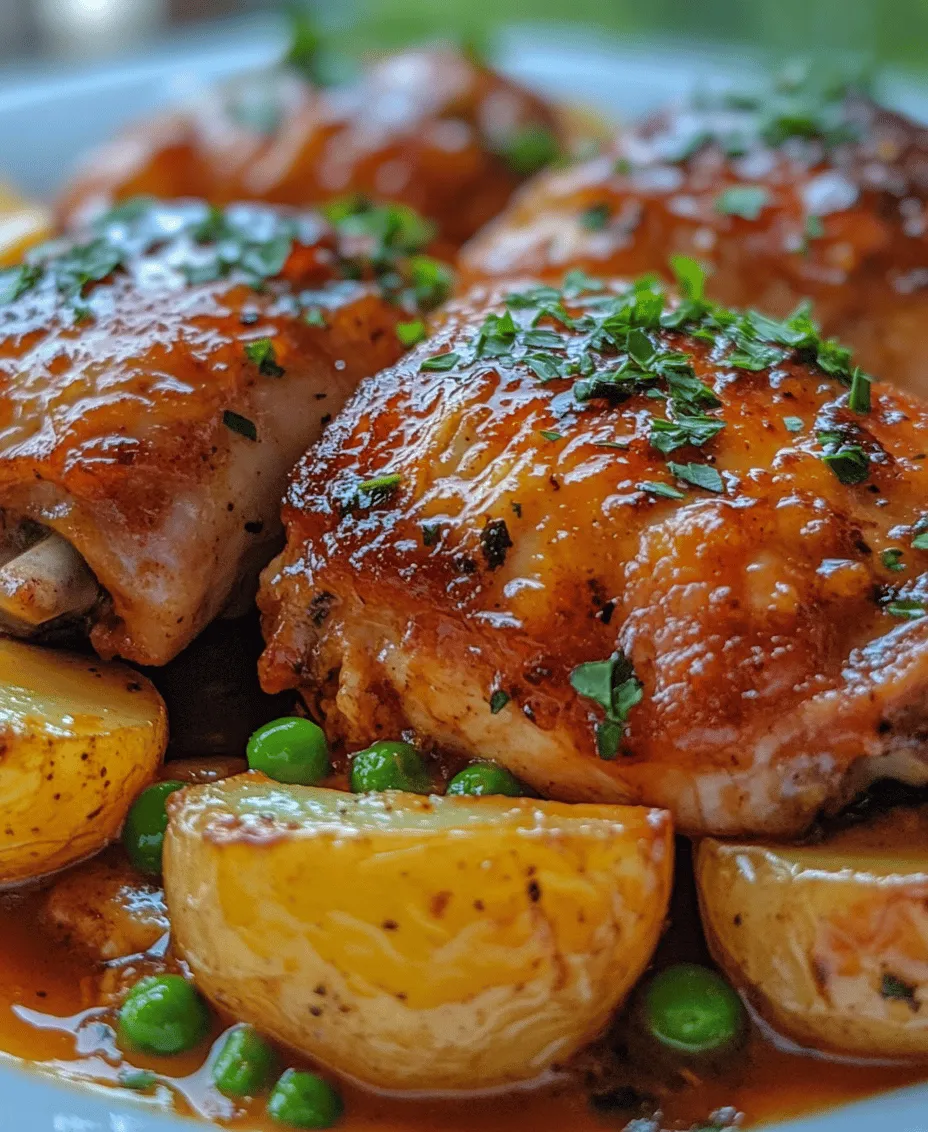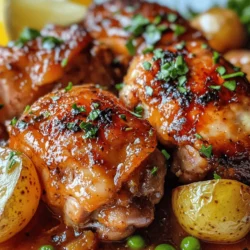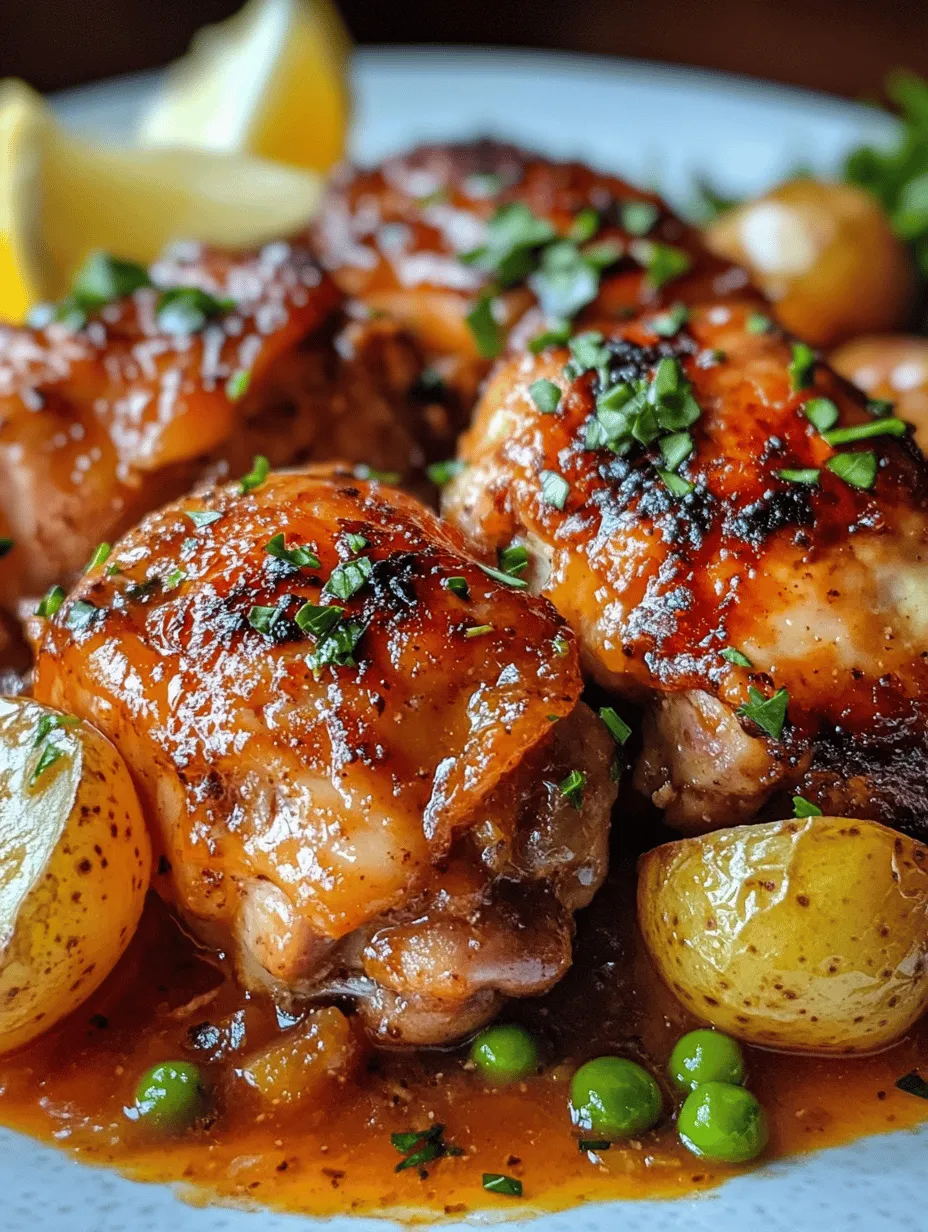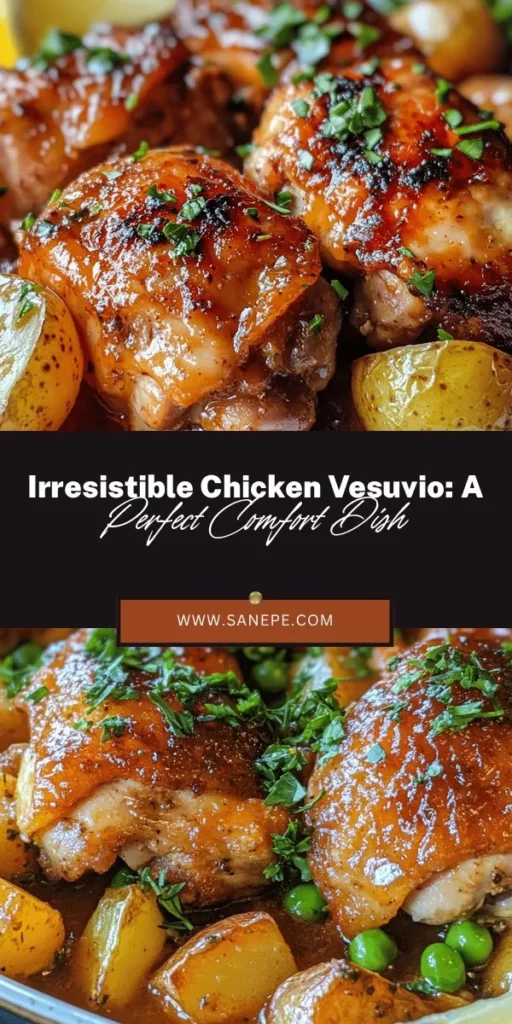Introduction
Chicken Vesuvio is a delightful classic in Italian-American cuisine that has captured the hearts and taste buds of many home cooks and culinary enthusiasts. This comforting dish brings together juicy chicken parts, tender baby potatoes, and vibrant green peas, all enveloped in a rich, flavorful sauce. Not only is Chicken Vesuvio known for its mouth-watering taste, but it’s also celebrated for its straightforward preparation, making it an ideal choice for family dinners or special occasions.
What sets this dish apart is not just the combination of ingredients but the harmony of flavors that come together in each bite. The savory notes of the chicken, the sweetness of the peas, and the earthy undertones of the potatoes create a well-rounded meal that pleases everyone at the table. Whether you’re serving it for a casual weeknight dinner or a festive gathering, Chicken Vesuvio is sure to impress.
To truly elevate this dish, it’s essential to use high-quality ingredients and employ proper cooking techniques. When you start with the best products, such as fresh herbs and good-quality chicken, your dish will shine even brighter. In this article, we’ll explore the background of Chicken Vesuvio, examine its essential components, and guide you through the process of creating this irresistible meal.
Understanding Chicken Vesuvio
Historical Context
Chicken Vesuvio has an intriguing history that mirrors the journey of Italian immigrants in America. It is believed to have originated in Chicago, where Italian-American chefs embraced traditional Italian cooking methods and infused them with local ingredients and flavors. The dish is named after Mount Vesuvius, the famous volcano in Italy, which symbolizes the fiery and robust nature of the recipe.
Over the years, Chicken Vesuvio has evolved from a simple home-cooked meal to a beloved staple in Italian-American restaurants. Its adaptability and rich flavors have made it a favorite among diners, allowing it to stand the test of time. As Italian cuisine became more popular in the United States, Chicken Vesuvio emerged as a definitive dish that represents the fusion of Italian heritage and American culinary creativity.
Key Characteristics
The flavor profile of Chicken Vesuvio is a beautiful blend of savory, spicy, and fresh elements. The chicken is typically seasoned to perfection, offering a succulent and juicy texture. The addition of garlic, oregano, thyme, and red pepper flakes introduces a fragrant aroma and a mild heat that complements the dish beautifully.
The baby potatoes, cooked to creamy tenderness, soak up the rich sauce, while the vibrant peas add a pop of color and a sweet crunch. The sauce itself, made with white wine and chicken broth, contributes depth and complexity, tying all the ingredients together in a harmonious blend. This balance of flavors and textures makes Chicken Vesuvio a truly irresistible dish that is both satisfying and comforting.
Ingredients Breakdown
Overview of Essential Ingredients
To recreate the authentic flavors of Chicken Vesuvio, it’s crucial to gather the right ingredients. Below is a breakdown of the essential components that will help you achieve the best results.
– Chicken Thighs: For this recipe, bone-in, skin-on chicken thighs are preferred. The bone adds moisture during cooking, while the skin crisps up beautifully, adding texture and flavor. Thighs are also more forgiving than chicken breasts, remaining juicy even if slightly overcooked.
– Olive Oil: A staple in Mediterranean cuisine, olive oil plays a significant role in cooking Chicken Vesuvio. It helps to brown the chicken and potatoes, enhancing their flavors and ensuring a deliciously crispy exterior.
– Aromatics: The combination of garlic, oregano, thyme, and red pepper flakes is essential for building flavor. Garlic adds a pungent richness, while oregano and thyme impart earthy notes. Red pepper flakes provide a gentle heat that balances the dish.
– White Wine and Chicken Broth: These two components are vital for creating a rich and flavorful sauce. White wine adds acidity and depth, while chicken broth enhances the overall taste, infusing the dish with savory goodness.
– Baby Potatoes: Choosing the right type of potato is crucial for achieving the desired texture. Waxy varieties, such as fingerling or new potatoes, hold their shape well during cooking, making them ideal for this dish.
– Frozen Peas and Lemon Juice: Peas add freshness and a vibrant color to Chicken Vesuvio. The addition of lemon juice brightens the dish, cutting through the richness while adding a zesty finish.
Tips for Ingredient Substitutions
While the traditional ingredients of Chicken Vesuvio are key to its authentic flavor, there are several substitutions you can make to accommodate dietary preferences or ingredient availability. Here are a few suggestions:
– Chicken: If you prefer a healthier option, boneless, skinless chicken thighs or breasts can be used, though they may require different cooking times. For a vegetarian version, consider using hearty vegetables like portobello mushrooms or eggplant.
– Olive Oil: While olive oil is the traditional choice, you can substitute it with avocado oil or vegetable oil for a different flavor profile.
– Aromatics: If you don’t have fresh herbs on hand, dried herbs can work in a pinch. Use about one-third of the amount of dried herbs compared to fresh. For a milder flavor, you can reduce the amount of red pepper flakes.
– Wine: If you prefer to cook without alcohol, you can replace white wine with additional chicken broth or a splash of white vinegar mixed with water.
– Potatoes: If baby potatoes aren’t available, you can use larger potatoes, just make sure to cut them into uniform pieces to ensure even cooking.
– Peas: Fresh peas can be substituted for frozen ones, but be sure to adjust the cooking time accordingly. If you want to add more vegetables, consider incorporating green beans or asparagus.
Step-by-Step Guide to Preparing Chicken Vesuvio
Preparation Overview
Before diving into the cooking process, it’s essential to prepare your workspace and organize your ingredients. This preparation will make the cooking experience smoother and more enjoyable. Gather all necessary ingredients and tools, such as a large skillet or Dutch oven, a cutting board, and a sharp knife. Make sure to wash and chop any vegetables, measure out your ingredients, and have your cooking utensils ready.
Detailed Cooking Instructions
1. Preparing the Chicken: Start by patting the chicken thighs dry with paper towels. This step is crucial for achieving crispy skin. Next, season the chicken generously with salt and pepper on both sides. To enhance flavor, you can also rub some minced garlic directly onto the skin.
2. Searing the Chicken: In a large skillet or Dutch oven, heat a few tablespoons of olive oil over medium-high heat. Once the oil is shimmering, carefully place the chicken thighs skin-side down into the pan. Sear the chicken for about 5-7 minutes, or until the skin is golden brown and crispy. Avoid overcrowding the pan; if necessary, work in batches.
3. Cooking the Potatoes: Once the chicken is browned, remove it from the pan and set it aside on a plate. In the same pan, add the baby potatoes, cut-side down, and sauté for about 5 minutes until they develop a golden crust. Stir occasionally to prevent sticking.
4. Adding Aromatics: After the potatoes are golden, add minced garlic, oregano, thyme, and red pepper flakes to the pan. Sauté for about 1-2 minutes, allowing the spices to become fragrant. This step is essential for building layers of flavor in the dish.
5. Deglazing the Pan: Pour in the white wine, scraping up any browned bits from the bottom of the pan. This process will not only enhance the flavor of the sauce but also add richness to the overall dish. Allow the wine to simmer for a couple of minutes until it reduces slightly.
6. Building the Sauce: Next, add the chicken broth to the pan, and return the seared chicken thighs to the skillet, placing them on top of the potatoes. This allows the chicken to absorb the flavors of the broth as it cooks.
7. Simmering: Cover the skillet and reduce the heat to low. Let the dish simmer for about 25-30 minutes, or until the chicken is cooked through and tender. During the last few minutes of cooking, add the frozen peas and a squeeze of fresh lemon juice to brighten the flavors.
By following these steps, you’ll be well on your way to creating a delicious Chicken Vesuvio that is sure to impress your family and friends. The combination of juicy chicken, tender potatoes, and vibrant peas makes for a satisfying meal that celebrates the heart of Italian-American cooking. Stay tuned for the next part, where we’ll delve deeper into serving suggestions and additional tips for perfecting this classic dish.

Searing the Chicken: Techniques for Perfect Browning and Flavor Development
To achieve that irresistible flavor and golden-brown crust in your Chicken Vesuvio, proper searing is crucial. Start by ensuring that your chicken pieces are dry; pat them down with paper towels to remove excess moisture. This step is essential because moisture can inhibit browning.
Heat a heavy-bottomed skillet or Dutch oven over medium-high heat and add a generous amount of olive oil. Once the oil shimmers, it’s ready for the chicken. Carefully place the chicken skin-side down in the hot oil, ensuring not to overcrowd the pan, which can cause steaming rather than searing. Allow the chicken to cook undisturbed for about 5-7 minutes, or until a deep golden brown forms on the surface. Flip the chicken and sear the other side for an additional 5 minutes. This technique not only develops flavor through the Maillard reaction but also creates a beautiful color that enhances the dish’s visual appeal.
Sautéing Aromatics: Timing and Techniques to Release Maximum Flavor Without Burning
Once the chicken is beautifully browned, it’s time to build the flavor base by sautéing aromatics. Remove the chicken from the pan and set it aside, leaving the rendered fat for the next step. Add minced garlic and onion to the hot oil, stirring frequently. Timing is critical here; you want to sauté until the onions are translucent and the garlic is fragrant, about 2-3 minutes. Be cautious not to let the garlic burn, as it can impart a bitter flavor to the dish.
For an even more robust flavor, consider adding a pinch of red pepper flakes at this stage. They will infuse the oil with a subtle heat that complements the richness of the chicken and potatoes.
Deglazing the Pan: Benefits of This Step for Enhancing Flavor and Creating a Rich Sauce
After sautéing the aromatics, it’s time to deglaze the pan. This technique involves adding liquid to lift the browned bits stuck to the bottom of the skillet, known as fond. Pour in a cup of dry white wine—this not only helps to release those delicious flavors but also adds acidity, which brightens the dish. Scrape the bottom of the pan with a wooden spoon to incorporate all those flavorful bits into the sauce.
Allow the wine to simmer for a few minutes until it reduces slightly, intensifying the flavors. This step is essential for creating a complex and well-rounded sauce that will coat the chicken and potatoes beautifully.
Cooking the Potatoes: Ensuring Even Cooking and Integration of Flavors
With the pan now infused with flavor, it’s time to add the potatoes. Cut them into uniform pieces—about 1-inch cubes—to ensure they cook evenly. Add the potatoes to the pan, stirring them to coat in the aromatic mixture. This will help them absorb all of the wonderful flavors you’ve developed thus far.
Next, pour in chicken broth to the pot, just enough to cover the potatoes halfway. The broth will help to keep the potatoes moist while they cook, allowing them to soak up the savory flavors. Bring the mixture to a gentle boil, then reduce the heat to a simmer. Cover the pan with a lid and let it cook for about 10-15 minutes, or until the potatoes are fork-tender.
Nestling the Chicken and Simmering: The Importance of Gentle Cooking for Juicy Chicken and Tender Potatoes
After the potatoes have softened, it’s time to nestle the seared chicken back into the pan. Place the chicken pieces on top of the potatoes, skin-side up, and spoon some of the broth over them to keep them moist. Cover the pan again and let everything simmer together for an additional 25-30 minutes. During this time, the chicken will absorb the delicious flavors from the broth and aromatics, becoming tender and juicy.
This gentle cooking method is crucial for achieving perfect results. The slow simmer allows the chicken to cook through without drying out, while the potatoes continue to soak in the savory broth, enhancing their flavor.
Finishing Touches: Adding Peas and Lemon Juice for a Burst of Freshness
As the simmering process nears its end, it’s time to add some finishing touches. Throw in a cup of frozen peas during the last 5 minutes of cooking. They will add a pop of color and a slight sweetness that balances the dish beautifully.
Just before serving, squeeze fresh lemon juice over the chicken and potatoes. This brightens the entire dish, cutting through the richness and adding a refreshing zing. Stir gently to combine and allow the dish to sit for a couple of minutes before serving, letting the flavors meld together.
Flavor Profiles and Cooking Techniques
Understanding the balance of flavors in Chicken Vesuvio is key to mastering this dish. Each ingredient contributes to the overall taste, creating a harmonious blend. The chicken provides a savory, rich base, while the potatoes absorb the surrounding flavors, becoming creamy and flavorful. Garlic and onion add depth and aroma, while the white wine adds acidity and brightness.
Cooking Techniques Explained
– Searing vs. Braising: Searing the chicken first creates a flavorful crust while locking in moisture. Braising, which occurs during the simmering phase, allows the chicken to cook gently in liquid, yielding tender, juicy meat.
– The Science of Simmering: Simmering at low heat allows flavors to develop without the risk of boiling, which can toughen meats. This method results in a comforting, tender dish that is full of flavor.
Serving Suggestions
When it comes to serving Chicken Vesuvio, consider pairing it with some ideal accompaniments. A simple green salad dressed with a light vinaigrette can provide a refreshing contrast to the richness of the dish. If you desire more carbs, a side of crusty bread is perfect for soaking up the delicious sauce.
For wine enthusiasts, a chilled glass of Sauvignon Blanc or a light-bodied Pinot Grigio pairs wonderfully, complementing the dish without overpowering its flavors.
Presentation Tips
Presentation is key to making your Chicken Vesuvio visually appealing. Spoon the chicken and potatoes onto a large platter, allowing the sauce to cascade over the top. Garnish with freshly chopped parsley for a splash of color and a fresh flavor. If desired, a few lemon wedges on the side can enhance the visual appeal and offer a hint of brightness.
Nutritional Information
A serving of Chicken Vesuvio typically contains around 400-500 calories, depending on portion size and specific ingredients used. It provides a balanced mix of protein, carbohydrates, and healthy fats, making it a satisfying meal.
– Protein: The chicken serves as a lean protein source, essential for muscle repair and overall health.
– Carbohydrates: Potatoes provide complex carbohydrates, offering sustained energy.
– Vitamins and Minerals: The addition of peas and herbs contributes essential vitamins, such as Vitamin C, and minerals, such as potassium.
The health benefits of this dish are significant. By using lean chicken and incorporating vegetables, Chicken Vesuvio stands out as a nutritious option while still being comforting and delicious.
Conclusion
Making Chicken Vesuvio is a delightful culinary experience that brings comfort and satisfaction to the table. The combination of juicy chicken, tender potatoes, and the vibrant flavors from aromatics and herbs creates a dish that is hard to resist.
We encourage you to try this recipe and savor the rich flavors and textures that it offers. Whether served for a family dinner or a gathering with friends, Chicken Vesuvio is sure to become a beloved favorite in your home.
Embrace the versatility of this dish; it can be adapted to suit various tastes or dietary needs. With its robust flavors and delightful presentation, Chicken Vesuvio is not just a meal—it’s a celebration of good food and togetherness.


